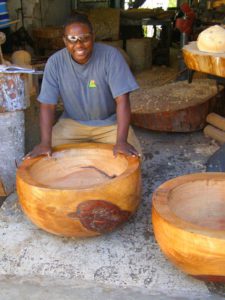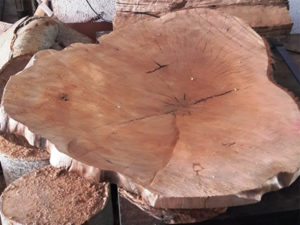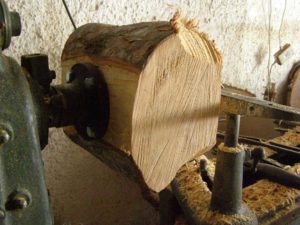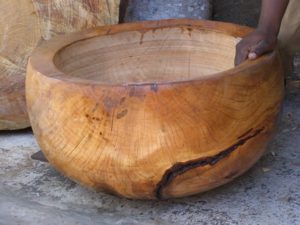24 Jun Wood by Emanuel
Tuesday, July 15th 2025
Master craftsman Emanuel Tankie from Zimbabwe executes each project flawlessly. Emanuel can work wood, steel, metal, bronze, glass and silver and has a number of projects on the go at any given time.
The wood is organically felled; huge trees that the South Easter winds have blown down – Alipensus Pine, Poplar, Stone Pine, Fig, Flower Gum, old Oak; he never cuts down a tree, it is all green wood harvested with sustainability in mind. When it goes on the lathe it has to be soft. Sometimes it’s left outside for a while for the sun to work its magic. Slabs of Stone Pine meters across which come from 300 year old trees are made into magnificent grained tables or enormous bowls.
The lathe itself has a story: It’s an old 1865 Watkin lathe made in Missouri that was used in the Second World War to make tanks. The lathe has been adapted so it can take an entire tree, enabling large vessels to be made from one solid piece of wood.
Some of the most interesting wood in the wood shop dates back to a ship that brought the French Huguenots to the Western Cape. Salvaged from the hull of a sunken vessel found in Table Bay harbour, the wood from the Andaman Islands called Padauk wood was cured by being underwater for 250 years. It’s interesting to note that the Japanese cure their wood by placing it under water and cutting off its oxygen supply. The wood is of a deep colour much redder than Rosewood and so solid that it sounds like metal when struck
The business started in September 2016 still lacks a name. Mannie says that the wood is just left lying around and eventually the ideas come after seeing the wood every day. There is no repetition of ideas. When a piece is finished the best part is letting it go to a new home.
Some favourite pieces…
Enormous bowls made from one solid piece of turned wood nearly a meter across. The raw bark is left on the bowl in certain spots to enhance its natural beauty. Clearly, turning a piece of wood this size is an engineering feat in itself.
The Liquid Amber tree in slices of almost two meters is left rough in the sun where it naturally develops into a gentle curve. Covered in epoxy it forms itself into unique platters that look frail but are as hard as stone.





